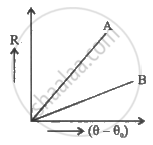Advertisements
Advertisements
Question
A glass full of hot milk is poured on the table. It begins to cool gradually. Which of the following is correct?
- The rate of cooling is constant till milk attains the temperature of the surrounding.
- The temperature of milk falls off exponentially with time.
- While cooling, there is a flow of heat from milk to the surrounding as well as from surrounding to the milk but the net flow of heat is from milk to the surounding and that is why it cools.
- All three phenomenon, conduction, convection and radiation are responsible for the loss of heat from milk to the surroundings.
Solution
b, c and d
Explanation:
When hot milk spreads on the table heat is transferred to the surroundings by conduction, convection and radiation. Because the surface area of poured milk on a table is more than the surface area of milk filled in a glass. Hence, its temperature falls off exponentially according to Newton’s law of cooling. Heat also will be transferred from the surroundings to the milk but will be lesser than that transferred from milk to the surroundings.
APPEARS IN
RELATED QUESTIONS
On a hot summer day we want to cool our room by opening the refrigerator door and closing all the windows and doors. Will the process work?
An ordinary electric fan does not cool the air, still it gives comfort in summer. Explain
Solve the following problem.
A metal sphere cools at the rate of 0.05 ºC/s when its temperature is 70 ºC and at the rate of 0.025 ºC/s when its temperature is 50 ºC. Determine the temperature of the surroundings and find the rate of cooling when the temperature of the metal sphere is 40 ºC.
A liquid with a certain surface area takes 10 minutes to cool from 80° C to 70° C. The time taken by it to cool from 80° C to 60° C is [The surrounding temperature being 40° C] ____________.
Two circular discs A and B with equal radii are blackened. They are heated to the same temperature and are cooled under identical conditions. What inference do you draw from their cooling curves?

A cup of coffee cools from 90°C to 80°C in t minutes, when the room temperature is 20°C. The time taken for a similar cup of coffee to cool from 80°C to 60°C at a room temperature same at 20°C is ______
A cup of coffee cools from 90°C to 80°C in t minutes, when the room temperature is 20°C. The time taken by a similar cup of coffee to cool from 80°C to 60°C at a room temperature same at 20°C is ______.
A cup of coffee cools from 90°C to 80°C in t minutes, when the room temperature is 20°C. The time taken by a similar cup of coffee to cool from 80°C to 60°C at a room temperature same at 20°C is ______.
Is the bulb of a thermometer made of diathermic or adiabatic wall?
According to Newton's law of cooling, the rate of cooling of the body is proportional to (Δθ), where Δθ is the difference between the temperature of the body and the surroundings, and n is equal to ______.
